Did someone say dog vomit color chart? Eeew! But wait, this might seem interesting. There are over 7 dog vomit colors? No way!
Practically, there are over 7 dog vomit shades but today we want to talk to you about the most common ones. Similar to a dog poop color chart, a dog vomit color chart describes dog vomit colors and what they mean to your dog’s overall health status.
While some dog vomit colors are less bad than others, dog vomiting is rarely a good sign. Different gastrointestinal problems, motion sickness, various metabolic diseases, and ingestion of foreign objects — these can all be common causes of dog vomiting which is often a cause of concern.
This dog vomit color chart is your ultimate dog vomit color guide that will help you keep your dog’s health in great condition.
Dog Vomit Color Chart Preview
The dog vomit color chart below shows the colors of dog vomit determined by the type and source of food as one of the common causes and different health problems that can cause dog vomiting.
| Dog Vomit Color | What It Means | What To Do |
|---|---|---|
| Brown | Undigested dog food, ingestion of poop | Monitor your dog |
| Dark brown | Internal bleeding, ingestion of poop | Call your veterinarian |
| White | Empty stomach, upset stomach, foreign object, Pancreatitis | Call your veterinarian |
| Yellow | Liver disease, kidney disease, food allergies, Bilious vomiting syndrome, gastrointestinal parasites | Visit your veterinarian |
| Green | Eating grass, poison ingestion | Visit your veterinarian |
| Red | Internal bleeding, traumatic injury, Gastroenteritis, poison ingestion | Visit your veterinarian |
| Black | Internal bleeding, poison ingestion | Visit your veterinarian |
What Color Is A Dog’s Vomit?
A dog’s vomit can be a huge pinwheel of colors — whatever your dog eats can turn into vomit. So, the more colorful your dog’s diet, the more colorful its vomit can get.
Usually, a dog’s vomit color ranges from white, transparent, yellow, green, red, brown to black. Regardless of white and yellow dog vomit color being less dangerous than black or red, dog vomiting should always be monitored and treated.
What Different Colors Of Vomit Mean In Dogs?
This is the moment that we all have been waiting for — what does each dog vomit color mean? Each of these dog vomit colors can be of different hues and different textures. The majority of dog vomit colors will depend on what the dog has eaten throughout the day. However, there can be many underlying health issues that are connected to the color of the dog’s vomit.
1. Brown Dog Vomit Color
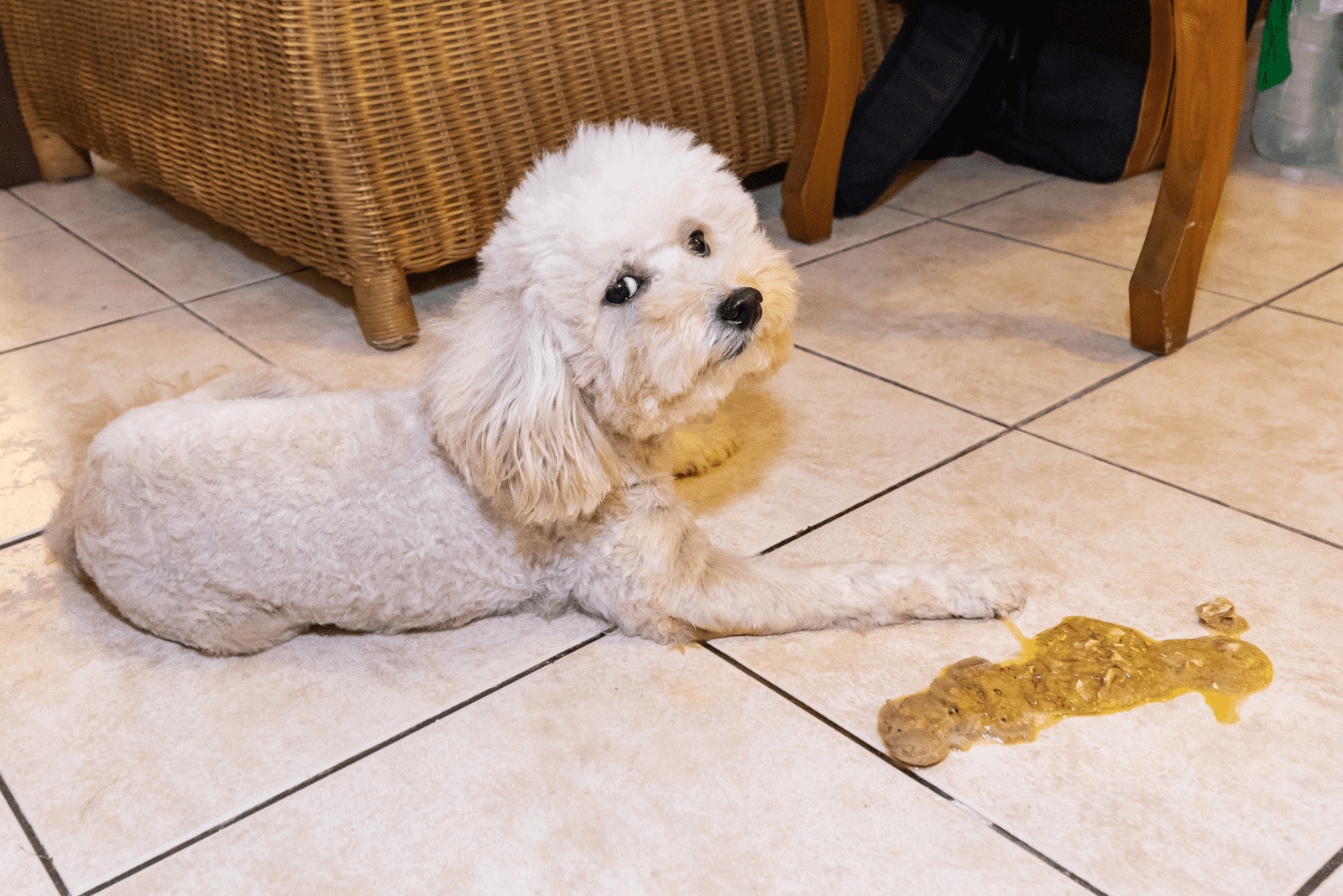
Did you know that brown vomit color is the most common out of all dog vomit colors? Why is it so common? You have probably already guessed it, so we will explain in depth about “why is my dog vomiting brown?”
Undigested Dog Food
Well, as far as I know, most of the kibble, puppy mush, and wet dog food is brown. Dogs also eat fresh meat that often turns brown once digested.
Some dog food/kibble ingredients simply don’t sit well and the dog’s sensitive stomach can’t tolerate them which leads to throwing up.
Blockage
Another possible cause of your dog vomiting brown can be due to gastrointestinal blockage in which your dog’s food is stuck within its esophagus.
More often than not, the dog that vomits brown a while after eating is probably a fast eater and got food stuck inside its esophagus. However, the blockage can be also caused by a foreign object such as a ball, rubber bands, or toys. Dogs like to eat socks and it seems that there is nothing we can do about it. But, once those socks cause blockage and other gastrointestinal issues, then silly play becomes a serious medical emergency.
Ingestion Of Poop
A common cause of dogs throwing up brown is eating cat poop or dog poop, quite literally. Let’s be real, we are all aware that some canines eat poop and even lick other canines’ urine! No wonder they throw up brown, right?
The term used for this feces-eating phenomenon in dogs is called “coprophagia”. If your dog has eaten poop, the smell of its brown vomit will be, you guessed it, like the smell of poop. Canine coprophagia is a health hazard because there is lots of bad stuff that is present in poop.
If your dog happens to eat poop with white specks, it will become infested with tapeworms. Besides smelly vomit, your dog’s breath is going to smell bad too.
Internal Bleeding
A rare, but serious issue is when the dog’s brown vomit is due to internal bleeding. To recognize if the dog’s vomit is the result of internal bleeding, look for small formations that resemble coffee grounds.
If your dog has internal bleeding, its vomit would be a more vivid brown to red color. You should bring your dog to the veterinarian straight away if you notice the coffee ground-like content of the vomit.
2. White Dog Vomit Color
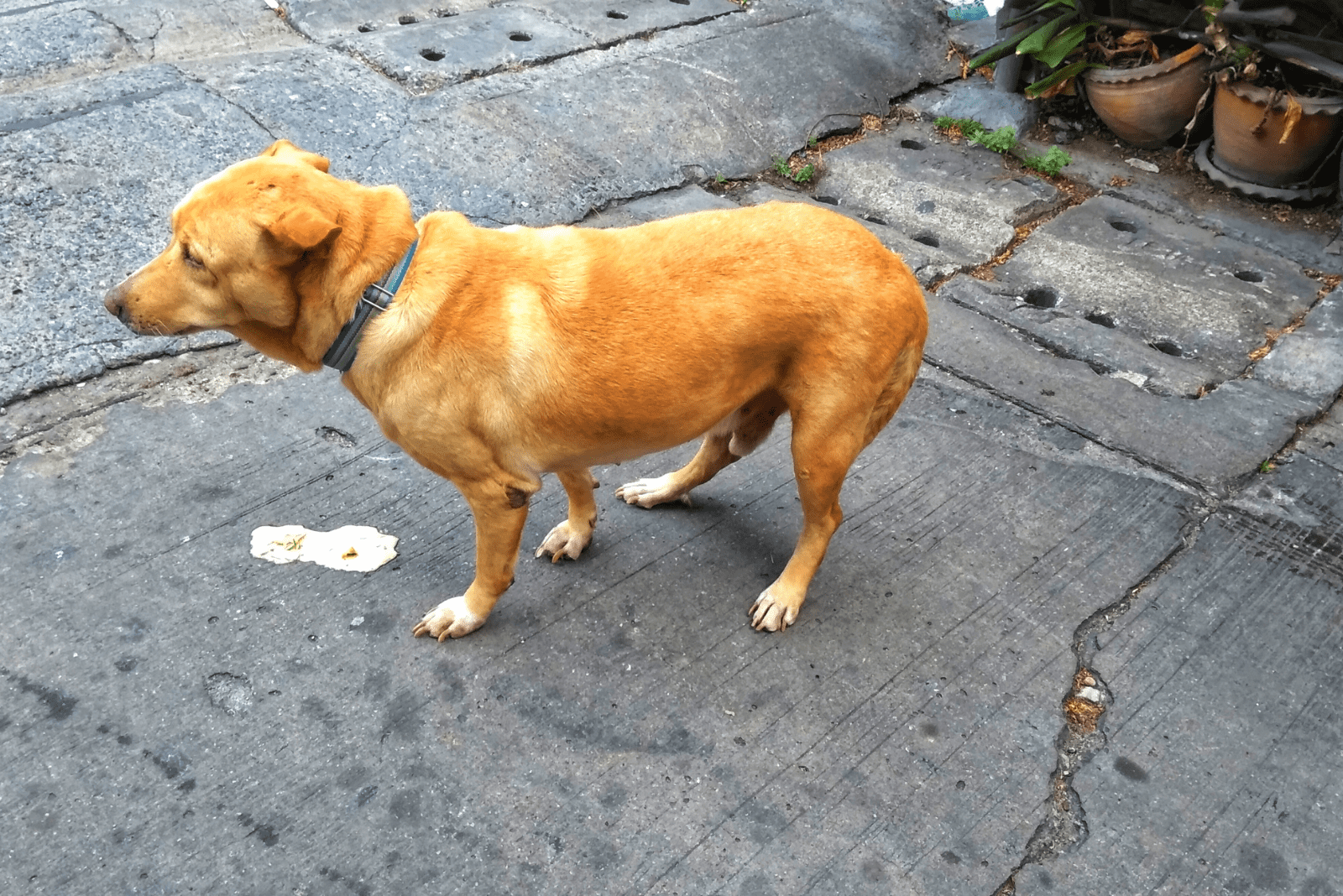
White vomit in dogs is often followed by a foamy or liquid consistency.
Depending on the white dog vomit consistency and frequency, pet owners can detect whether or not it is a medical emergency.
Empty Stomach
Dogs that haven’t eaten much may throw up white to transparent liquid vomit. So, what you’re seeing in the white liquid dog vomit is saliva and bile.
Although this is not always a medical emergency, dogs that throw up white liquid vomit should be monitored. When you think about it, hungry dogs should not vomit, so white liquid dog vomit could indicate underlying health issues.
It may also indicate that the dog may suffer from an eating disorder in which it is always hungry, but can not eat.
In addition to white liquid vomiting, dogs experience signs of nausea, drooling, inappetence, and abdominal pain.
Motion Sickness
If you like to travel by bus, car, plane, or boat, you have probably experienced motion sickness at least once in your life. Those who haven’t — lucky for you!
Just like humans, dogs can experience motion sickness and it makes them throw up! Dogs that suffer from motion sickness usually experience white or transparent liquid vomit.
If dogs are given food moments before traveling, this can cause sickness and vomiting. However, if the dog hasn’t eaten anything before traveling, then the food may have nothing to do with its vomiting.
Instead, what causes dog motion sickness vomiting is its constant drooling and panting, especially in the car.
Foreign Object Ingestion
The ingestion of non-food items is called canine pica.
Similar to when the dog is having blockage, foreign object ingestion can lead to a white liquid/foamy vomit. Because the foreign object gets stuck in the dog’s stomach or esophagus, it may cause the blockage of the whole gastrointestinal tract.
Dogs love to eat all sorts of stuff — sometimes dogs even eat underwear! Whatever the dog ingests that is not considered food, is a potential health hazard.
The most frequent foreign objects that dogs ingest include socks, rubber bands, parts of their toys, as well as sticks, plastic wrappers, and so on.
At first, the dog will gag but not throw up the foreign object. After it succeeds in throwing up the foreign object is covered in saliva and transparent to white liquid vomit.
But, there are times when foreign objects stay inside the dog’s stomach for a few days. The longer the period of time, the more health problems the foreign object can cause.
Pancreatitis
For worried pet owners that raise the question “What color is pancreatitis vomit in dogs?” — I got you. Pancreatitis in dogs refers to the inflammation of the pancreas which leads to dogs throwing up white foam.
If the dog has none of the previously mentioned causes of vomiting, then pancreatitis is something to consider. However, you have to monitor your dog to notice other symptoms of pancreatitis:
• Abdominal pain
• Signs of nausea
• Diarrhea
• High Fever
• Inappetence
• White foamy vomit
If you think that your furry friend is suffering from pancreatitis, then it is time you take it immediately to the vet to receive proper therapy and diet.
Kennel Cough
As the name implies, kennel cough is a health problem in dogs that includes coughing. And coughing equals irritated and/or sore throat. In this case, there is no other irritant (dog food, foreign object) than cough that causes white vomit in dogs.
The dog’s transition from a warm room to a cold, as well as drinking water, can cause coughing which can turn into vomiting white mucus.
Kennel cough can be caused by several bacteria and/or viruses which means that it is very contagious. If you have more than one infected dog, chances are that all of them will have kennel cough.
Canine Bloat (Gastric Dilatation Volvulus)
Canine bloat is a serious issue that needs immediate veterinary care. Besides a bloated, upset stomach and abdominal pain, the major signs of canine bloat are vomiting white foam. Alongside these obvious signs of bloat, dogs may show signs of nausea and dry heaving or unproductive retching.
If you happen to notice that your dog is bloated, hurry to your veterinarian because your dog’s life is in danger.
3. Yellow Dog Vomit Color
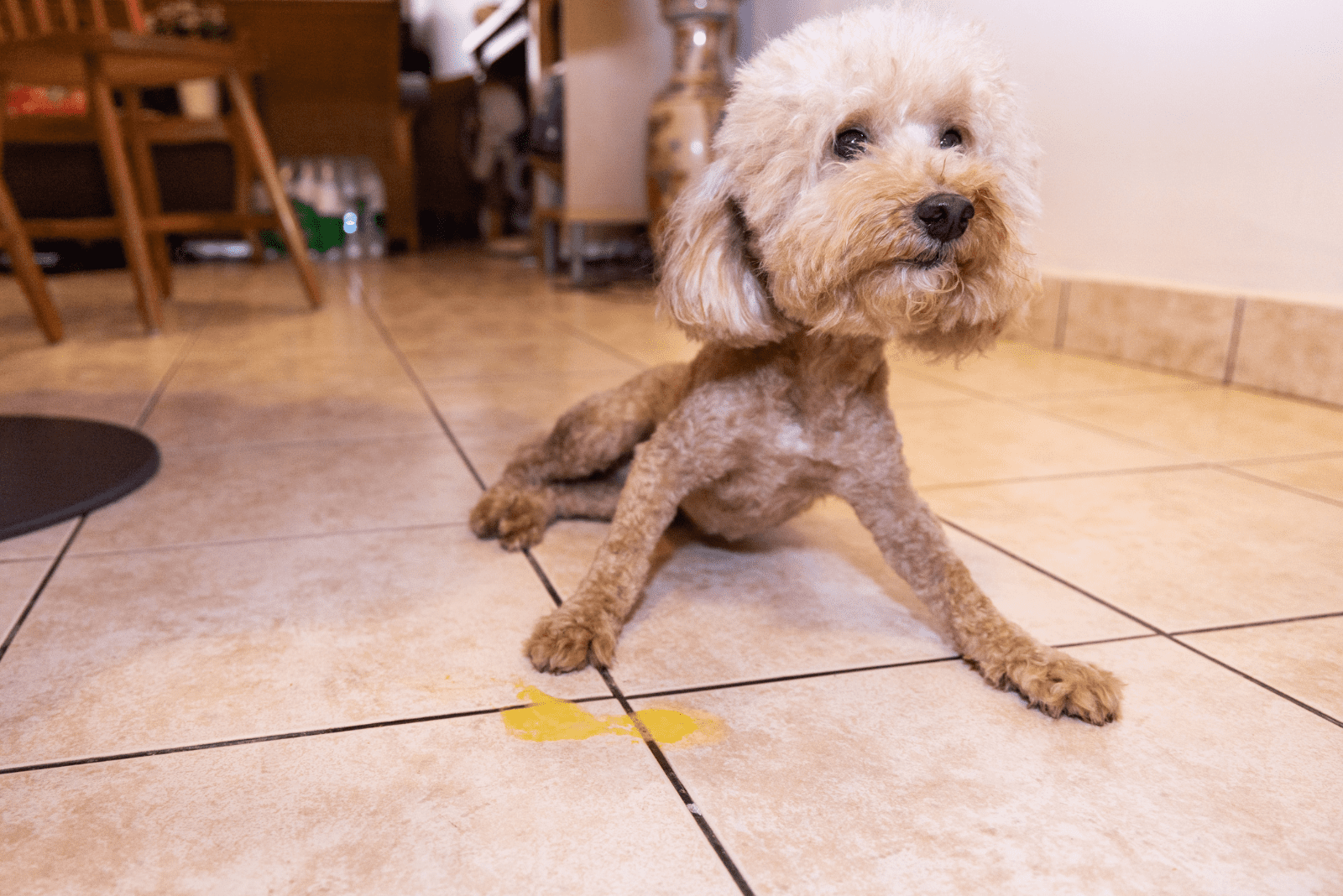
You see, the most common causes of yellow dog vomit include acute conditions such as foreign object ingestion, an empty stomach, and heatstroke, it is also a common cause of several chronic illnesses.
The reason why your dog is throwing up yellow may be due to food allergies and dietary changes. Besides that, here are several health issues that are to blame for dog vomiting yellow:
Bilious Vomiting Syndrome
This health problem has the word “vomiting” in it, so you can guess what’s going on here. The canine bilious vomiting syndrome (BVS) is a serious issue that affects the dog’s health. It causes early morning vomiting of yellow.
The reflux of bile into the stomach is what causes the urge to vomit and because the bile is greenish to yellow, the vomit content is colored yellow.
Liver Disease
Several liver diseases such as canine jaundice can cause the dog to vomit yellow. Liver diseases cause the buildup of toxins inside the dog’s body because the liver is not functioning as it should be. The buildup of toxins and chemicals causes dogs to feel nauseous which eventually leads to vomiting.
However, the vomiting in dogs that suffer from certain liver diseases is not entirely explained.
Kidney Disease
In addition to inappetence and yellow dog vomit, kidney disease can cause dogs to feel nauseous which triggers the vomiting episodes.
Alongside vomiting, dogs that suffer from kidney disease pee often and feel lethargic.
That said, dogs with kidney disease require a special kind of diet like homemade food for kidney disease.
Acid Reflux
Dogs with acid reflux experience stomach acid coming from the gastrointestinal tract up to their esophagus. This acid makes the dog uncomfortable and causes harm to esophageal tissue. Stomach acid irritates the dog’s esophagus which leads to the urge to vomit. If a dog vomits, the color of stomach acid is going to be yellow.
Even though acid reflux in dogs can be cured with medicine and surgery, it is recommended that dog owners prepare homemade meals for their dogs. For example, boiling chicken for your dog has many benefits against acid reflux because it is a light meal that your dog’s sensitive stomach can handle.
Parasitic Infestation
The presence of parasites inside the dog’s digestive system can make a whole mess! Not only do infested dogs feel lethargic, weak, and nauseous, they may have frequent vomiting episodes.
The vomit can be yellow or white in color, liquid or foamy. During severe gastrointestinal parasitic infestations, dogs may even throw up worms!
If you suspect that your dog is infested with parasites, take a walk to your vet to take some antiparasitic meds!
Food Allergies
Believe it or not, in addition to skin rashes, food allergies in dogs may also cause vomiting of yellow content. Besides the yellow dog vomit color, pieces of brown-colored undigested food can be found in the vomit.
If the dog vomits a few minutes after eating food that it is allergic to, then it will throw it out alongside yellow or transparent liquid.
4. Green Dog Vomit Color

You can guess where this is coming from — dogs like to eat grass! In addition to eating grass, dogs consume different green vegetables like brussels sprouts and kale, which turn their vomit and poop green.
However, green dog vomit color can also indicate that the dog is vomiting bile that ranges from green to yellow.
Eating Grass
If you think that a dog eating grass is odd, then let me remind you that our furry friends like to eat poop too. But, the grass is what colors our dog’s vomit (and poop) from green to bright green. Some dogs suddenly eat grass like crazy and worried owners are trying to find ways to stop them!
Cooked green veggies are easy for dogs to digest, but eating grass might not feel good for your dog’s gastrointestinal tract.
After ingesting raw grass, dogs may cough to get the grass out of their system. Most of the time, this will lead to the dog vomiting the piece of grass that has been stuck in its esophagus. If the grass reaches the dog’s stomach, then it will try to digest it. If it fails, the dog will vomit bright green to dark green vomit.
5. Red Dog Vomit Color
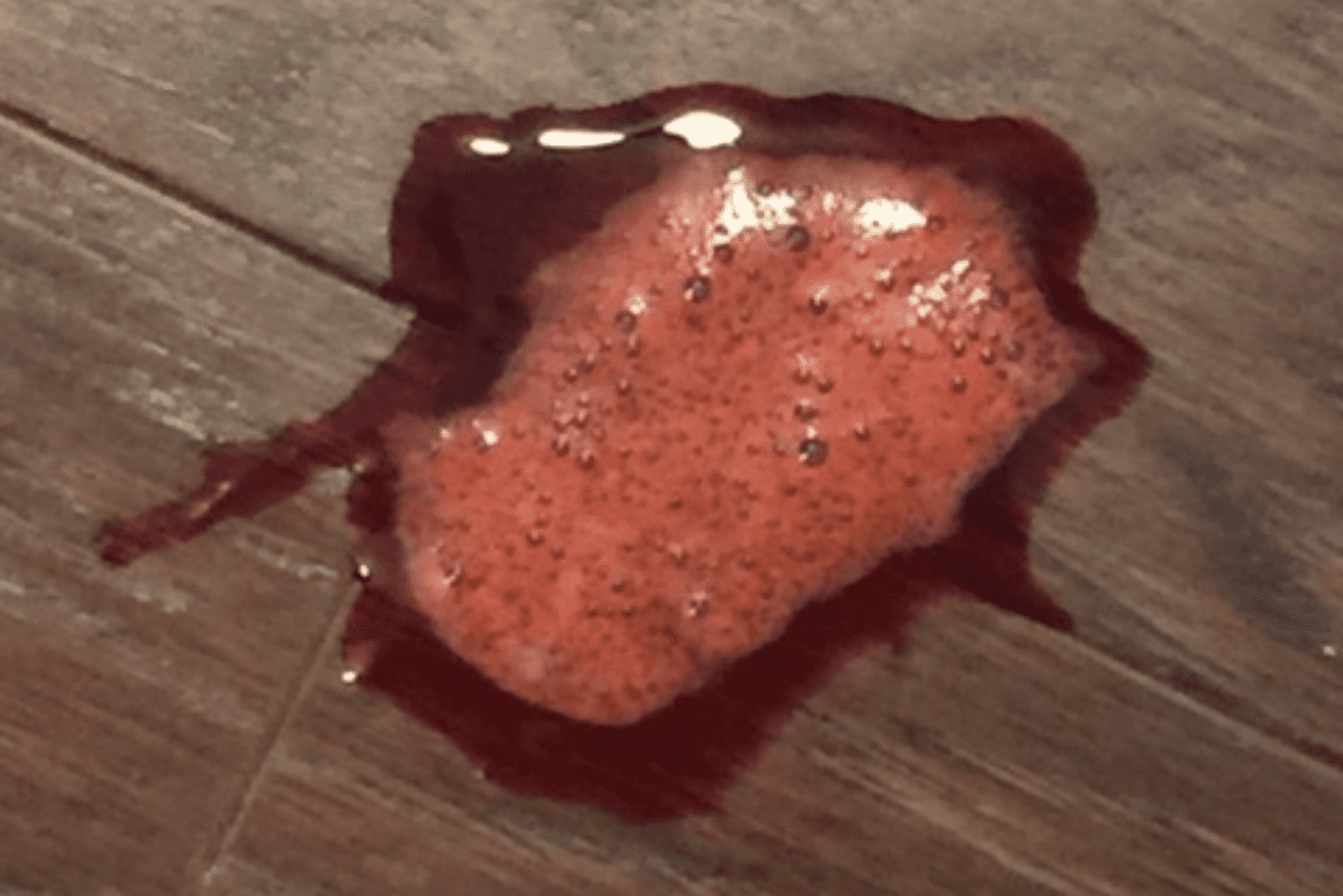
Whenever you see red coming out from your dog’s mouth or bum, know that it is time to see the vet. The red color in dogs is always a medical emergency that needs medical surveillance and care.
The red dog vomit color indicates that there is blood somewhere (most likely gastrointestinal tract) in the dog’s body. Here is how it can happen:
Traumatic Injury
Dogs that have endured a traumatic injury (car accident, fall, crush) suffer from either internal or external bleeding or both! In all cases, traumatic injury in dogs requires veterinarian care. If the dog starts vomiting red, then there is internal bleeding present in its digestive system that needs proper medical attention.
The bleeding can be also connected to brain injury and the dog feeling nauseous, which leads to vomiting.
Gastroenteritis
Gastroenteritis in dogs is another way to say “inflammation of the digestive system”. This means that both the stomach and intestines of a dog can be inflamed due to bacteria or viruses. The most common cause of gastroenteritis in dogs is natural, “good” gut bacteria that have turned into “bad” bacteria.
While the majority of dogs that suffer from gastroenteritis throw up yellow or white foamy vomit, if it is not treated and cured on time, chronic gastroenteritis can lead to dogs vomiting red.
Red color can also be found in the dog’s loose stool and indicates internal bleeding that may be caused by different agents. Gastroenteritis in dogs can also be caused by toxins and poisons, so it is important to monitor the affected dog.
Ingestion Of Poisons
Ingestion of chemical poisons (rodenticide, insecticide, disinfectants) is another common cause of why dogs vomit red. Other than chemical poisons, food toxins can cause red dog vomit. Depending on the type of ingested poison, dogs may experience different symptoms.
Vomiting red or even blue vomit (if the poison is blue) is the most common sign that the dog has eaten poison. Poisonous plants can also cause red or green liquid to foamy vomit in dogs.
Again, depending on the type of poison, the symptoms may occur straight after your dog has ingested it, or a few hours later. Because not only is the digestive system of a dog in danger, but also its nervous system, this is a medical emergency that needs immediate intervention.
6. Black Dog Vomit Color

Similar red black to dark brown dog vomit color indicates that there is internal bleeding in the dog’s gastrointestinal tract.
The black vomit color can quite possibly be a sign of ulcers in the dog’s digestive tract, as well as injury, inflammation, or ingestion of poisons. The main thing pet owners should pay attention to is finding coffee ground-like formations in black dog vomit. This is an indicator that the dog is coughing and vomiting out digested blood that has coagulated and looks like small coffee grounds.
Black dog vomit color is never a good sign and pet owners must hurry to the veterinarian to help their dog recover as soon as possible.
7. Gray Dog Vomit Color
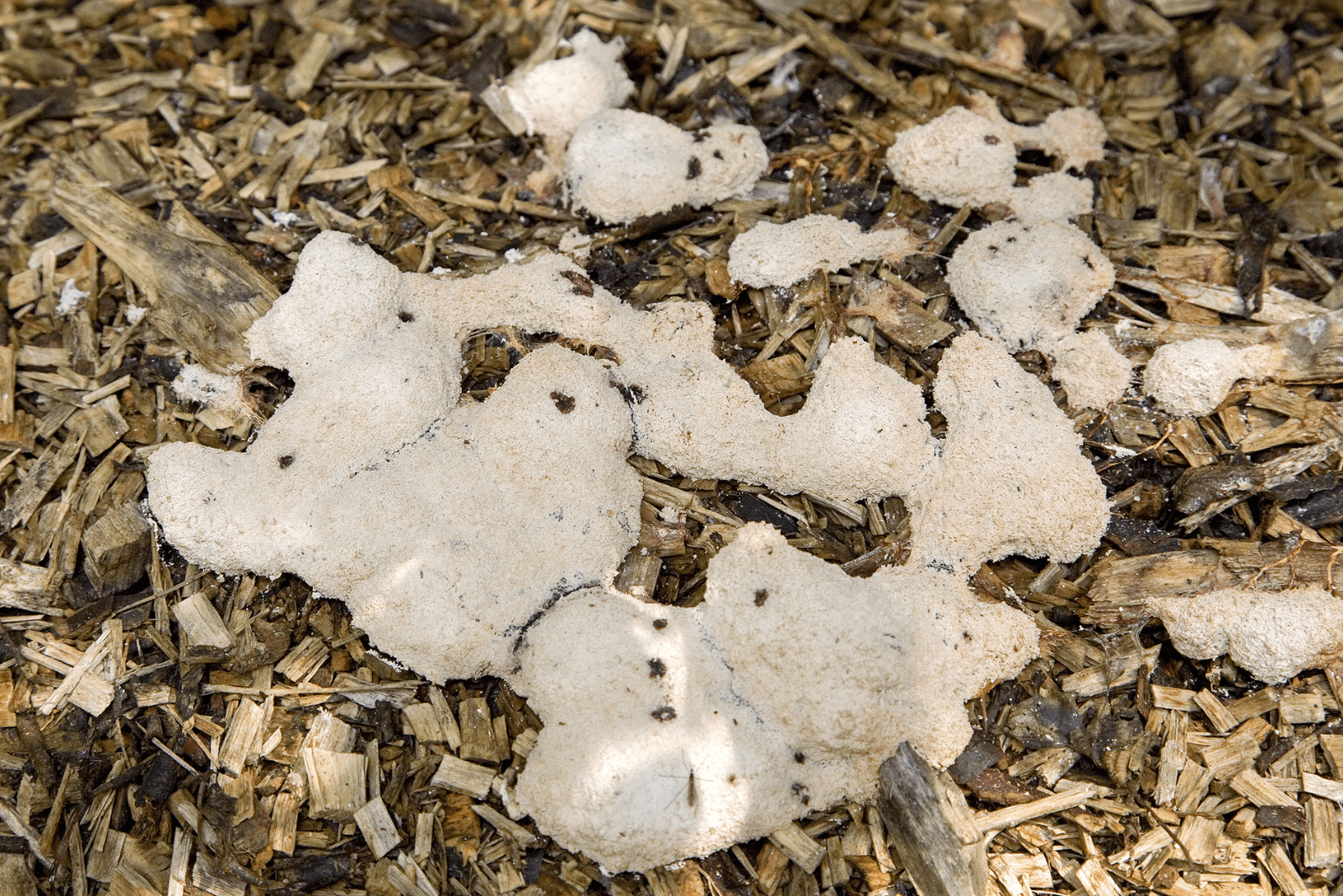
The last dog vomit color that we want to talk about is gray, which is not often seen. Gray dog vomit is usually liquid at the beginning of vomiting episodes, but it can turn foamy if the dog keeps vomiting.
In contrast to red and black dog vomit, gray is not as dangerous. Gray dog vomit color may show that your dog’s stomach is empty or upset.
Diluted bile is what gives this dog vomit color its gray shade.
Dog Vomiting Vs Dog Regurgitation
These two terms seem to always be mixed up, but knowing the difference between dog vomiting and regurgitation will help you, your dog, and your vet in the long run. I mean, your vet would like to know if the dog vomited, or if it just regurgitated.
Dog vomiting usually appears straight after a meal and it involves throwing up digested or undigested food. That said, pet owners can see when their dog is vomiting by looking at its abdominal retching sounds, hypersalivation, and physical effort to get the vomit out.
In contrast to dog vomiting, dog regurgitation happens a few minutes after the dog has eaten. During regurgitation, there is no digestion of dog food. So, the food that comes out of your dog’s mouth is undigested and in big chunks. Therefore, the dog vomit is usually brown with visible pieces of kibble. Dog regurgitation is not followed by abdominal retching sounds or dry heaving.
In other words, dog vomiting is when contents are brought up from the dog’s stomach, while dog regurgitation is when contents are brought up from the esophagus.
You may want to give your dog a helping hand when it is throwing up, but it is best not to disturb it during this time.
Conclusion
Let’s face it — vomiting is not a feeling that anyone wants to revive their memory of. If our dogs could talk, they would probably say that vomiting is among their top three least favorite things. Who can blame them, right?
Like it or not, as a pet owner, you will probably encounter your beloved dog vomiting here and there. This is why it is important to know all there is about the dog vomit color chart.
Distinguishing between brown and black vomit and figuring out when it is a medical emergency might just save your dog’s life. Even though this dog vomit color chart features seven dog vomit colors, they can have different shades — bright yellow, orange, bright green, dark brown, pale red, etc.
In addition to dog vomit color, pet owners must inform the veterinarian of all changes in the dog’s vomit consistency and frequency.
Related Content
What Are The Worst Dog Food Brands On the Market?
Dog Tongue Color Chart: What Color Is A Sign Of A Healthy Dog?
How Long Does It Take For A Dog To Gain Weight?













